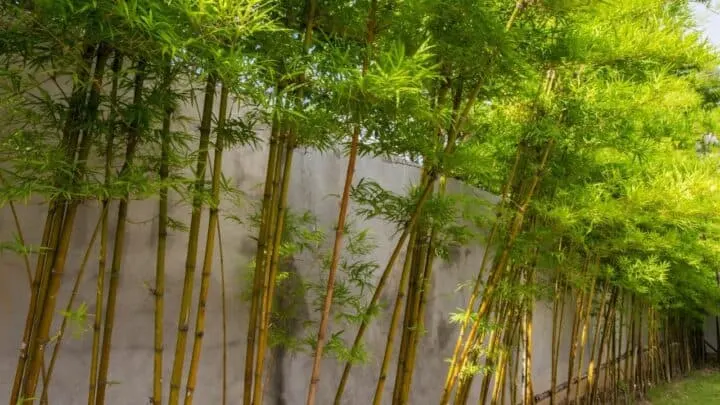A very prolific plant, bamboo can outgrow the area where it lives very quickly. However, since it tends to run, this can be problematic, and transplanting bamboo becomes necessary.
Here we will address transplanting bamboo into your garden. When you transplant and where you plant your bamboo, it will help you be successful in your endeavors.
The different types of bamboo are also a factor when transplanting bamboo, as running bamboo roams freely while the other grows in tight clumps and spreads more slowly.
If you have bamboo and wonder if it needs to be transplanted, follow along. We will figure it out, and when we are finished, you will know how to transplant bamboo.
Table of Contents
How to Transplant Bamboo?
Transplant bamboo only before new shoots are growing or after growth has ended, preferably in early spring or late fall. Then, dig up the plant’s large rhizome (root ball) area. By digging up a large clump of roots, you will ensure success when they are replanted. Once you have removed the root ball, keep it dampened until you get it planted in its new home.
What Kind of Bamboo You Have
There are two types of bamboo, with two types of roots, and the variety you have will dictate how you tackle how to transplant bamboo.
The one type has running roots that go out everywhere and replant themselves as they go. The other type grows in clumps, and the root balls get thick and hard.
Both varieties of bamboo are prolific but should only be transplanted in early spring before new shoots appear.
Or you can transplant them in autumn before the first frost after all growth has stopped for the season. When transplanting bamboo, you can move it to a new sunny location or put it into pots.
Gather your Transplanting Tools
The roots of either type of bamboo are tough, and you will need a sharp spade, an ax, and a saw to cut them into manageable sections.
However, if your goal is to thin your crop of bamboo, then you can selectively cut out some clumps while leaving others to grow.
However, if you intend to transplant your bamboo from one location to another, then roll up your sleeves, we’re going to be here for a while.
The bamboo roots are tough, and you will need a sharp shovel, an ax, garden shears, and a saw to cut away the growth from the root ball. You will also need these tools to divide the bamboo into sections that can be replanted.
Add a sheet of plastic and a watering can or water hose to your list of must-haves. The roots that you dig up will need to remain moist until they are replanted.
So, once you have dug them up, place them on the sheet of plastic, dampen them, and loosely wrap them up. This procedure will keep your bamboo from drying out before you can get it back in the ground.
Where to Transplant Your Bamboo
Bamboo will grow in bright indirect light and loamy, well-drained soil. However, it will grow almost anywhere if it gets the proper nutrients, water, and even a little sunlight.
It is a very forgiving plant that makes a great privacy fence and windbreak.
If you have a patch of bamboo that needs to be thinned, then you have the choice to plant what you dig up in another location in your yard, or you can put it in a container or two.
Bamboo does well in pots and will add to your décor indoors and out.
Prepare the Site for your Bamboo Transplants
Before you even begin to dig up your bamboo, you need to have a place to move it to. Whether that is another location or into a collection of pots is up to you.
However, preparation for your bamboo transplants needs to be done first.
The roots of bamboo will dry out very quickly. Therefore, if you wait to prepare an area to replant your bamboo, it may dry out and die before you can get it back in the ground.
For bamboo to grow to its potential, it will need to be planted in loamy soil with good drainage. It should have a pH of about six, which is slightly acidic soil, and the soil should drain well but still hold moisture.
Planting bamboo in an area where the roots cannot dry out can kill your plants.
Frequently Asked Questions about How to Transplant Bamboo
Can I move my bamboo from the garden into pots?
As mentioned earlier, you can move bamboo into pots. When you are cutting the bamboo rootball, make the pieces small enough to put into a container. Just make sure that your container is large enough to hold the plant as it grows in height and girth.
Does bamboo need special care after it is transplanted?
Your transplanted bamboo will need to be watered a couple of times a week after transplanting. For an arid area, you may need to water four or five times per week. Apply the same care for the bamboo that you have in pots.
Are there different bamboo types?
Indeed, there are. There is bamboo that grows in clumps and a type that runs. The clumping variety of bamboo will stay in a relatively confined area unless you let it run wild and give it no attention. Running bamboo, however, does just that; it runs and will take over a place if left unchecked.

Daniel has been a plant enthusiast for over 20 years. He owns hundreds of houseplants and prepares for the chili growing seasons yearly with great anticipation. His favorite plants are plant species in the Araceae family, such as Monstera, Philodendron, and Anthurium. He also loves gardening and is growing hot peppers, tomatoes, and many more vegetables.


